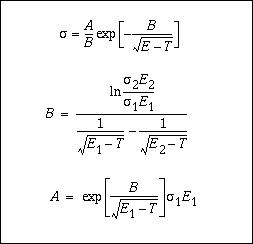The function y(x) is represented by a series of tabulated values, pairs of x and y(x), plus a method for interpolating between input values. The pairs are ordered by increasing values of x. There will be NP pairs given. The complete region over which x is defined is broken up into NR interpolation ranges. An interpolation range is defined as a range of the indendent variable x in which a specified interpolation scheme can be use; i.e., the same scheme gives interpolated values of y(x) for any value of x within this range. The definitions of the quantities in the interpolation table follow:
|
The allowed interpolation schemes are
|
Interpolation code INT=1 (constant) implies that the function is constant and equal to the value given at the lower limit of the interval.
Note that where a function is discontinuous (for example, when resonance parameters are used to specify the cross section in one range), the value of x is repeated and two different y values are given to make a discontinuity.
Examples of Interpolation Tables
The most common interpolation table in the ENDF/B files simply specifies that linear-linear interpolation is used throughout the range of x.
NR=1
NP=10
10 2
A more interesting example might be as follows:
NR=3
NP=10
2 2 6 5 10 1
which says that linear-linear interpolation is used between the
first point (e.g., the threshold) and the second point.
Log-log interpolation is used between the second and fifth points,
and histogram interpolation is used above the fifth point. For
histogram interpolation, the value of x for the last point
is used to define the end of the range of y(x) and the
y value is ignored.
Charged-Particle Cross Sections
A special one-dimensional interpolation law, INT=6, is defined for charged-particle cross sections. It is based on the limiting forms of the Coulomb penetrabilities for exothermic reactions at low energies and for endothermic reactions near the threshold. This scheme gives a concave upward energy dependence near the threshold that is quite different from the behavior of the neutron cross sections. At higher energies, non-exponential behavior will normally begin to appear, and linear-linear interpolation is more suitable. The formulas for INT=6 follow:

where E1,σ1 and E2,σ2 are two consecutive points in the cross-section tabulation. In these formulas, T=0 for exothermic reactions (Q>0). For endothermic reactions, T is the kinematic threshold.